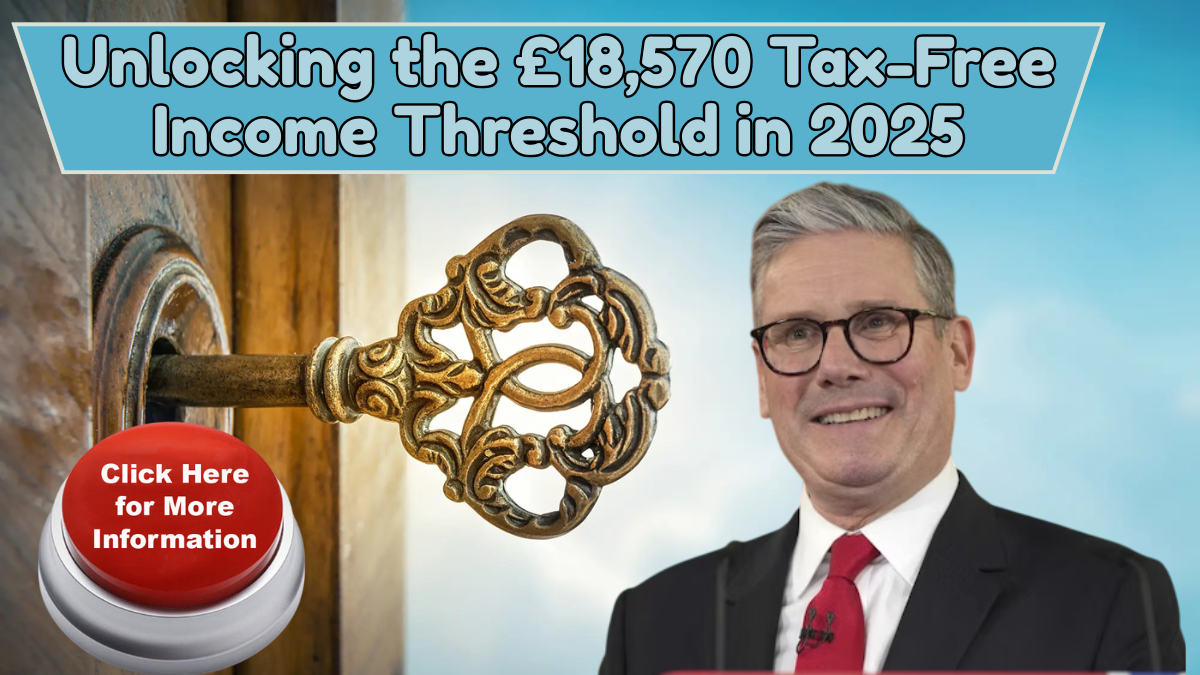In 2025, a mind-blowing variety of individuals inside the UK will obtain as much as £18,570 in tax-free economic help from the Department for Work and Pensions (DWP). That has made a great number of people wonder, how does it work, and who is able to claim it? Whether you’re suffering with a long-term infection, being concerned for a disabled cherished one, or on a low income, this help can be available to you.
But here’s the vital bit: £18,570 isn’t a single lump sum for absolutely everyone. Instead, it’s the most every year quantity you would possibly get by way of combining positive DWP blessings, relying on your scenario.
In this guide, we’ll break down
- Which blessings add up to this overall
- Who qualifies for them in 2025?
- How much each gain pays
- How to test if you’re eligible
We’ll additionally share guidelines on the way to observe and keep away from not unusual errors that would slow down or even block your claim.
Understanding the £18,570 Figure: What It Really Means
Let’s begin by debunking the myth: £18,570 isn’t a one-off that the DWP is giving to every citizen in 2025. Rather, it’s the joint annual sum of some DWP benefits specifically:
- Personal Independence Payment (PIP)
- Carer’s Allowance
- Universal Credit (limited capability or carer components)
- Attendance Allowance
- Severe Disability Premium (in legacy benefits)
Each of these advantages is tax-free, in that you get them without paying tax, and in the majority of instances, they don’t qualify as taxable income or influence your income tax limit.
A person who is eligible for the maximum rates of more than one of these allowances can claim assistance of up to or even over £18,570 annually.
Major Benefits That May Amount to £18,570 in 2025

1. Personal Independence Payment (PIP)
PIP is financial assistance to folks who are over 16 and state pension age and feature a lengthy-time-period health condition or disability that has an effect on the ability to take part in everyday living or sports or has an influence on mobility.
It consists of two elements:
- Daily Living Component (for assistance with daily activities)
- Mobility Component (for assistance with mobility)
Both elements can be paid at a standard or enhanced rate.
PIP Weekly Rates from April 2025 (approximate):
- Daily Living:
- Standard: £72.65
- Enhanced: £108.55
- Mobility:
- Standard: £28.70
- Enhanced: £75.75
Annual PIP Total (enhanced daily living + enhanced mobility):
- £108.55 + £75.75 = £184.30 per week
- £184.30 × 52 weeks = £9,583.60 per year (tax-free)
This would mean that a person getting both higher rates of PIP could get almost £9,600 a year, making up much of the £18,570 amount.
2. Carer’s Allowance
Carer’s Allowance is to assist the carers of someone who receives a qualifying disability benefit, which incorporates the Daily Living thing of PIP, for at least 35 hours every week.
2025 Carer’s Allowance weekly charge: £81.90
- £81.90 × 52 weeks = £4,258.80 in line with annum
It’s well worth noting:
- Carer’s Allowance is taxable, even though the majority of recipients do not earn enough to pay tax.
- Carer’s Allowance and the carer detail of Universal Credit can’t be claimed at the same time—every other advantage with a better price might be paid.
If you’re both on PIP as a disabled individual and a carer for a person, you may not be eligible to make a claim for Carer’s Allowance yourself; however, any other relative should make a claim for looking after you.
3. Universal Credit (with Carer or Disability Element)
Universal Credit is an allowance for individuals on a low income or unemployed. It has elements (additional payments) if you:
- Are a carer
- Have limited ability for work
- Have responsibility for a disabled adult or child
Key Components (2025 forecast rates):
- Carer Component: £198.31 per month
- £198.31 × 12 = £2,379.72 per annum
- Limited Capability for Work and Work-Related Activity (LCWRA): £416.19 in step with the month
- £416.19 × 12 = £4,994.28 consistent with annum
If you qualify for each, the simplest one might be paid, no longer each on the equal time.
Some human beings integrate Universal Credit (carer detail) with Carer’s Allowance; however, the Carer’s Allowance can be counted as income inside the Universal Credit calculation, decreasing the UC award.
Still, receiving the LCWRA detail by myself can carry in just below £5,000 per 12 months tax-unfastened.
4. Attendance Allowance (for those over State Pension age)
Attendance Allowance is for people above state pension age who require assistance due to illness or disability.
Two rates:
- Lower rate: £72.65 per week
- Higher rate: £108.55 per week
Yearly maximum:
- £108.55 × 52 weeks = £5,644.60 a year (tax-free)
It’s important to know that you cannot receive Attendance Allowance and PIP at the same time. You can claim one or the other based on your age at the time of claiming.
5. Severe Disability Premium (legacy benefits only)
Although not a part of Universal Credit, some people are still entitled to legacy benefits such as Income Support or Income-Based ESA, possibly with the inclusion of the Severe Disability Premium (SDP).
2025 weekly SDP amount (single person): approx. £81.50
- £81.50 × 52 = £4,238 per year
To be eligible, you:
- Have to get PIP Daily Living or Attendance Allowance
- Must live alone (or only with others who are also eligible)
- Not have a person on claim for Carer’s Allowance on their behalf
Even though new applications for legacy benefits are no longer accepted, not all households have yet been switched over to Universal Credit and so are still on SDP.
Example: Merging Benefits to Total £18,570
Suppose someone is entitled to
- Increased PIP daily living + mobility = £9,583.60
- Carer’s Allowance (for the care of someone else) = £4,258.80
- Universal Credit with LCWRA element = £4,994.28
Total Annual Support (tax-free) =
£9,583.60 + £4,258.80 + £4,994.28 = £18,836.68
This man or woman might receive greater than £18,500 in tax-free assistance, demonstrating that the £18,570 figure is well within reach, even though it relies on numerous enjoyable eligibility standards.
Who Is Eligible for These Benefits?
While numerous humans may need to obtain £18,570 in tax-unfastened assistance, eligibility depends on certain and, every so often, strict necessities. This is the evaluation:
For PIP
- 16 to state pension age
- Suffer from a health condition or disability likely to persist for at least 12 months
- Struggle with daily living or mobility
- Need to go through an assessment process
For Carer’s Allowance
- Care for at least 35 hours/week
- The person you look after gets PIP or equivalent.
- Earn under £151 per week (after costs).
- Not in full-time education
For Universal Credit with Extra Components
- On a low income or not working
- Pass the Work Capability Test for disability components.
- Look after someone or have poor ability to work
- Don’t have more than £16,000 in savings.
For Attendance Allowance
- Be over state pension age.
- Be disabled or ill to the point of needing assistance.
- Not claiming PIP currently
How to Apply

To apply for any of these, you will need to apply through the DWP by phone, post, or online, depending on the benefit.
Apply for PIP
- Ring 0800 917 2222 to start.
- You’ll be sent a form and might have to go for an assessment.
Apply for Carer’s Allowance
- Go through the online portal on GOV.UK.
- Give information about the person you care for and your income.
Apply for Universal Credit
- Apply online at [gov.uk/universal-credit]. (https://www.Gov.United kingdom/usual-credit)
- You may want to visit a Work Capability Assessment.
Apply for Attendance Allowance
- Obtain the declaration form from the GOV.UK website or by calling 0800 731 0122.
Final Thoughts: Is the £18,570 Actually Available?
Yes, the amount of £18,570 is a realistic sum of tax-free DWP benefit that many individuals in the UK will have in 2025—but only if they are eligible for several benefits and get the enhanced or increased rates.
It’s no longer a one-off handout, and now not everybody can be eligible. But for human beings with ongoing disabilities, caring desires, or difficult wishes, the United Kingdom benefits device is designed so that it could pay out massive sums of money every 12 months without it being taxed.
If you agree with yourself or a member of your family is probably eligible, the finest element you may do is
- Assess your position realistically.
- Talk to a welfare advisor.
- Submit with complete documentation and clarity.
Whether you are suffering with a chronic infection, taking care of a loved one, or just preserving your head above water in tough instances, this help can be a godsend—and gaining knowledge of the way to get it is the satisfactory area to start.
FAQs
What benefits make up the £18,570 tax-free assistance?
It includes Personal Independence Payment (PIP), Carer’s Allowance, Universal Credit, Attendance Allowance, and Severe Disability Premium for some.
How much can you receive from PIP in 2025?
If eligible for both components at enhanced rates, you could receive up to £9,583.60 annually from PIP.
Can Carer’s Allowance be claimed alongside PIP?
Carer’s Allowance can be claimed only if you care for someone else; it cannot be claimed alongside PIP for self.

